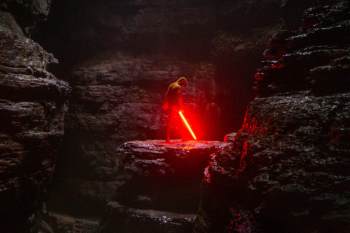What Order Should You Read the Rick Riordan Books?
Want to jump into Rick Riordan’s elaborate mythological universe but are unsure of where to start? It can indeed be quite daunting, considering there are over 30 books in all! Luckily, we’re here to explain what order you should read the Rick Riordan books.
You should read the Rick Riordan books either in order per series or in chronological order. In order per series is the easiest way to read Riordan’s books, as you’ll be focusing on the same characters and following a continuous plot.
In the rest of this article, we will learn more about these ways of reading Rick Riordan’s books, list the titles according to each order, and discuss the advantages of each reading order. Let’s get right to it!

How To Read Rick Riordan’s Books In Order per Series
If you have never read any book in Riordan’s mythological universe, arguably the best way to go about it is to read his books in order by series. By reading per series, you get to understand the context better, as you will be following one continuous plot and focusing on the same characters.
Riordan’s universe is quite an elaborate one, and people often get lost when they don’t follow this order precisely because there’s a lot to remember! If you’re following the story in order per series, the characters and their feats are fresh in your memory, allowing you to fully appreciate the story.
If you follow this order, here’s what your reading list should look like according to series:
- Percy Jackson and the Olympians
- The Demigod Files
- The Heroes of Olympus
- The Demigod Diaries
- The Kane Chronicles
- Crossovers
- Magnus Chase and the Gods of Asgard
- The Trials of Apollo
Below I have outlined the different series and the books included in each one.
1. Percy Jackson and the Olympians
This is the series that started it all, so this is where you should begin. There’s a reason why Riordan’s work is almost synonymous with Percy Jackson.
- The Lightning Thief (2005)
- The Sea of Monsters (2006)
- The Titan’s Curse (2007)
- The Battle of the Labyrinth (2008)
- The Last Olympian
2. The Demigod Files
This is a short story collection written from the perspective of Percy Jackson. All the stories in this book are related to the storylines that occurred during the first series. In other words, this collection provides additional context to the events already covered in the previous series.
3. The Heroes of Olympus
This series picks up from where Percy Jackson and The Olympians left off and is meant to be read as a continuation of the first series. If you want to fully appreciate this series, you have to make sure to read the first two beforehand.
- The Lost Hero
- The Son of Neptune
- The Mark of Athena
- The House of Hades
- The Blood of Olympus
4. The Demigod Diaries
This is another short story collection based on The Heroes of Olympus series. This book is very similar to The Demigod Files in terms of the format. It’s a great way to further explore the world of the previous series and see the story from a different perspective!
5. The Kane Chronicles
You won’t get to see much of Percy Jackson in this series, but there will be a mention or two of him and other familiar characters. This series is totally different from the previous ones, though, so approach it with the expectation that you’re getting something new.
- The Red Pyramid
- The Throne of Fire
- The Serpent’s Shadow
6. Crossovers
You can read the books in this series without having read the previous ones, but you won’t be able to fully appreciate them if you choose to read them that way. The stories in these books are closely connected with those in the Percy Jackson and Olympus series.
- The Son of Sobek
- The Staff of Serapis
- The Crown of Ptolemy
7. Magnus Chase and the Gods of Asgard
This is a series based on Norse Mythology, whereas the first two series in this list were based on Greek and Roman mythology.
- The Sword of Summer
- The Hammer of Thor
- The Ship of the Dead
8. The Trials of Apollo
The final series in this order, The Trials of Apollo, features many familiar characters from the original Percy Jackson series. It’s a satisfying, action-packed finale to Rick Riordan’s collection of novels.
- The Hidden Oracle
- The Dark Prophecy
- The Burning Maze
- The Tyrant’s Tomb
- The Tower of Nero
How To Read Rick Riordan’s Books In Chronological Order
This order is best for those who have finished all (or most) of Riordan’s books and are thinking of re-reading them just for fun. Aside from revisiting the characters and their stories, you also get to see the stories from a different perspective and gain a new way of “reading” the plot.
It’s also a great way to better understand the characters, their backgrounds, and how they evolve throughout the storyline if that’s something that you’re interested in. However, expect to be jumping from one series to another with this reading order.
This is what reading in chronological order looks like:
- The Greek Gods
- The Greek Heroes
- The Diary of Luke Castellan
- The Lightning Thief
- The Sea of Monsters
- The Titan’s Curse
- The Battle of the Labyrinth
- Percy Jackson and The Stolen Chariot
- Percy Jackson and The Bronze Dragon
- Percy Jackson and The Sword of Hades
- The Red Pyramid
- The Throne of Fire
- The Last Olympian
- The Singer of Apollo
- Percy Jackson and The Staff of Hermes
- The Lost Hero
- The Red Pyramid
- Son of Magic
- The Serpent’s Shadow
- Leo Valdez and The Quest for Bufford
- The Son of Neptune
- The Mark of Athena
- The House of Hades
- The Blood of Olympus
- The Son of Sobek
- The Staff of Serapis
- The Crown of Ptolemy
- The Sword of Summer
- The Hidden Oracle
- The Hammer of Thor
- The Dark Prophecy
- The Burning Maze
- The Hammer of Thor
- The Ship of The Dead
- 9 From the Nine Worlds
- The Tyrant’s Tomb
- The Tower of Nero
Conclusion
Among the two different ways to read Rick Riordan’s books, we highly recommend the first one: reading in order per series. This will help give you a more coherent and continuous concept of the interconnected stories, characters, settings, and the overall plot.
However, at the end of the day, you do you. As long as you’re enjoying your book, who’s to say you’re not doing it right?






